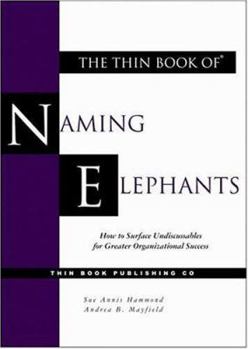The Thin Book of Naming Elephants: How to Surface Undiscussables for Greater Organizational Success
Select Format
Select Condition 
Book Overview
There's an elephant in the room that everyone knows about but no one is acknowledging. The elephant is implicit and undiscussable and lurks in every organization. Everyone talks around the elephant... This description may be from another edition of this product.
Format:Paperback
Language:English
ISBN:0966537351
ISBN13:9780966537352
Release Date:July 2004
Publisher:Thin Book Publishing Co.
Length:120 Pages
Weight:0.58 lbs.
Dimensions:9.0" x 0.5" x 6.5"
Customer Reviews
5 ratings
A Striking Case Study on Organizational Culture
Published by Thriftbooks.com User , 16 years ago
Anyone who has worked in a corporation knows that an elephant is not just an animal with four legs and a trunk -- an elephant is an issue or problem standing in the middle of the room that everyone knows about but no one is willing to acknowledge or deal with. Elephants are "undiscussables" present in every organization. The size and depth of these "undiscussables" are proportional to the vitality of the organization. It's my experience that high-performing, well-functioning companies have cultures in which honest debate is welcomed, assumptions and conclusions are openly mined for their basis in reality, and people are skilled in managing conflict. Unhealthy, dysfunctional organizations almost without exception have many elephants as a hallmark. In the book "The Thin Book of Naming Elephants--How to Surface Undiscussables for Organizational Success," authors Hammond and Mayfield utilize the chilling report issued by NASA's Columbia Accident Investigation Board (CAIB) as a striking case study on organizational culture. The CAIB report concluded that NASA's broken safety culture had as much to do with the accident as the foam, and that the nature of the numerous undiscussables at NASA, the pressures of rigid hierarchy, and many unquestioned assumptions led to the fatal disaster. While not every organizational elephant can lead to the loss of life or livelihood, the author's brilliantly make the case for a "simple but not easy" component of business's success: dialogue as a core competency. Specifically, they outline clear how-to strategies for achieving the following: · Speak up and share any concern or idea · Respectfully disagree or agree to disagree · Share and debate multiple realities · Question those in power · Explore many alternatives before shutting down discussion or making decisions · Take turns playing devil's advocate or the contrarian Much of my work involves helping leaders discuss and debate issues in ways that produce shared understanding, informed decisions, and high-quality solutions. I consider "The Thin Book of Naming Elephants" a key textbook in my toolkit, and recommend it for those who simply seek to sharpen their personal communication ability as well as for those actively involved in moving organizational culture.
Better than thin book on appreciative inquiry if you can believe it
Published by Thriftbooks.com User , 17 years ago
I love this book! Simple and powerful and ever so relevant. This is a must read for anyone involved in organizational or community change. You can create healing and remove the hidden agenda's that prevent you from moving ahead. Clear and powerful work with outstanding examples. A must read.
Eating the elephant in the room one bite at a time.
Published by Thriftbooks.com User , 18 years ago
This is a super little book that will have a huge impact on you and your organization! By following the simple steps outlined in this book you will be able to discuss the undiscussables, identify the unidentifyable, and make progress collectively like you never dreamed was possible. Another very helpful tool for your leadership toolbox!
Packs powerful insights for organizational change!
Published by Thriftbooks.com User , 19 years ago
The authors examine the idea that major problems are often not 'discussable,' although they are talked about in a destructive manner, and remain implicit. The consultant should help surface these "elephants" in a constructive dialogue, and push forward to making decisions, determining what are the next steps, and following through. This practical book provides guidelines to show how to achieve organizational change by learning to name "elephants" and take action. High Reliability Organizations, which reward people for pointing out any deviations from the expected, are discussed. The style of leadership needed to achieve change through getting people to open up and constructively participate in problem solving, is explored. This thin book is both broad and deep, and proves highly informative and thought provoking. It packs powerful insights for organizational change!
Hubris Arrogance and Screamers
Published by Thriftbooks.com User , 19 years ago
This book is right on target whether you are working with a company or with a non-for-profit. I found myself continually underlining relevant ideas. Hammond puts concepts we already know but tend to hide in the back of our minds in simple language that reminds us of how important it is to look at assumptions, accountability and involvement at all levels. She forces us to look at the consequences of speaking up vs not speaking up. I am an advocate (although after reading Hammond's book I am thinking of choosing a word that is less win-lose) of appreciative inquiry methods and also using public involvement in decision making processes and this book is in perfect alignment with both areas.




